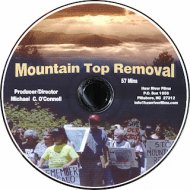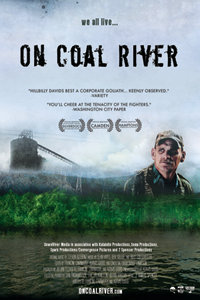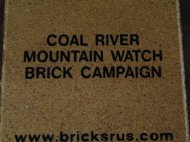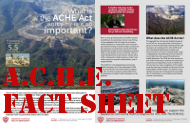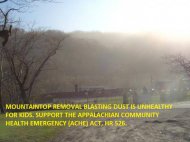
- Home
- About
- Projects
- Get Involved
- Resources
- Newsletters
-
Photos
- Rally In Richmond 2007
- Rally At Goals Coal 2005
- Ed Wiley In Charleston, WV 2005
- 2007 Coal Bowl
- Appalachia Rising 2010
- Mountain Top Removal
- Flyover June 2015
- Mountaintop Removal Blasting Above Sundial, WV, Aug. 13, 2015
- Mountaintop Removal Flyover Oct 10, 2015
- Visiting Student Groups
- Flyover With 60 Minutes Dec. 10, 2015 (flyover By Southwings.org)
- Flyover March 8, 2016 Part 1 Coal River Mountain
- Flyover March 8, 2016 Part 2 Cherry Pond Mountain: Edwight, Naoma
- Flyover March 8, 2016 Part 3 Cherry Pond Mountain (Twilight, Jarrell Cemetery)
- Links
- CRMW In The News 2025
- Cessation Orders Issued For Active Mine Permits
- It's Giving Tuesday--Please Chip In
- Thanks For Speaking Out
- Oppose A NEW Mountaintop Removal Permit On Coal River Mountain
- Comment 9/30/25 To Protect 3 Square Miles Of Forest, 3 Miles Of Streams, And Keep 56 Million Tons Of Coal In The Ground
- Keep 56 Million Tons Of Coal In The Ground
- Thanks For The Car!
- Still Needing $ For Our Monitoring Vehicle
- Lexington Coal Company's Doubly Delinquent $3 Million In Fines
- Comment 3/25/2025 To Oppose Renewal Of A Waste Coal Reprocessing Site
- Remember Buffalo Creek
- Environmental Groups Sue To Challenge Mountaintop Removal Mine On Coal River Mountain
- We Need A Replacement Truck
- Citizens' Enforcement Program Update
- Citizens Enforcement Program Update
- Holding Them Accountable
- Public Hearing March 21, 5 PM, Regarding Renewal Of Mountaintop Removal Permit
- Say No To Renewal Of Mountaintop Removal
- Giving Tuesday Fundraiser For The Judy Bonds Center For Appalachian Preservation
- CRMW Holds WVDEP, Lexington Coal Co. Accountable
- Oppose More New Mountaintop Removal Today
- We Object To Renewed Mountaintop Removal
- 50 Year Anniversary Of Buffalo Creek Disaster
- Just Say No To Renewed Mountaintop Removal
- Year End Update
- Recent Aerial Videos
- We Still Object
- We Object
- More Death Approved
- Appalachian Communities Health Emergency Act Introduced
- Stop Poisoning Our Community
- Tell WVDEP To Deny New Mountaintop Removal On Coal River Mountain
- Throwback Thursday: Victory Ten Years Ago
- Court: Northern Long-eared Bat Was Unlawfully Denied Endangered Species Protection
- Happy New Year From Coal River Mountain Watch!
- Recent Flyover Videos Of Coal River Mountain
- Tadpole Project Cleanup Saturday Sept 21
- College Students Tour Active Mountaintop Removal
- Peachtree Falls Cleanup Photos
- Celebrate 20 Years With Us July 20!
- Vote Tadpole!
- Mountaintop Removal Health Hearing April 9 At 2
- Appalachian Communities Health Emergency Act Introduced
- Mountaintop Removal On Coal River Mountain
- Intern Spotlight
- Human Rights Watch Report: The Coal Mine Next Door
- Groups Sue Alpha For Unlawful Mountaintop Removal
- Take Action To Deny An Invalid Mountaintop Removal Permit
- Public Hearings For Electric Rate Hikes
- Eagle 2 Mountaintop Removal Update
- Eagle 2 Update
- Voices For Appalachia - A Portrait-Story Project - Displayed At The Judy Bonds Center
- 6th Annual Peachtree Falls Cleanup
- CRMW Testimony At Congressional Coal Hearing
- Coal River Mountain Watch Program Summary
- Tadpole Project Update, Pitch In This Monday
- New Drone, New Breathtaking Videos
- New Coal Violation Pollutes Coal River
- Federal Health Study Shenanigans
- CREEK Scavenger Hunt
- Growing Like A Weed
- 1,200 Excess Deaths Every Year
- Must Watch! Dr. Hendryx On Why Mountaintop Removal Must End.
- Coal River Hemp Update
- WV PSC: Suspend And Deny Double-Digit Electric Rate Hikes
- Save Coal River Mountain
- Tadpole Project Cemetery Cleanup
- Reunited And It Feels So...Nasty: Alpha & Contura Merge
- They Crossed The Line
- Stripping Away Coal River Mountain
- Coal River Hemp Workshop Saturday, March 31
- Speak Out April 12
- Thank You Students!
- Mountaintop Removal Update
- Dumps Are Higher And Better Use Of Mountains?
- On The Big Screen And On The Road
- Mountain Music And Medicinals (and Tacos)
- Senate Intern Gets STEEP Tour
- Thanks And Farewell To Our January Intern From Oberlin College
- Mountaintop Removal Violations Just Keep Piling Up
- Mountaintop Removal Blasting Complaint, 7-mile Radius
- Year-end Donations For Tadpole Project And CREEK
- Challenge Met!
- Battery Not Included
- Welcome To Our Hemp Project Volunteer
- STEEP Challenge 9 Days Left
- CRIMP Reveals New Violation On Coal River Mountain
- Showing And Telling On The Road
- #GivingTuesday Matching Donations For The STEEP Challenge
- Putting A CRIMP In Mountaintop Removal
- A STEEP Climb Lies Ahead
- China Investing In WV Fracking And Chemicals
- Great News! Huge STEEP Steps Taken For 100% Solar!
- What Lies Upstream? Upwind? Uphill?
- Revolt: Coal River Mountain (Newsy Report On Mountaintop Removal And Health)
- A STEEP Challenge To Go Solar
- New Drone Footage Of Mountaintop Removal On Coal River Mountain
- VICE....This Guy Flies Drones Over Coal Mines To Monitor Toxic Slurry Lakes
- Alpha Natural Resources Cited For 8th And 9th Violations At Mountaintop Removal Site On Coal River Mountain
- Remember Labor Day!
- Remembering Judy Bonds On Her 65th Birthday
- Mountaintop Removal Health Review Halted
- Coal Or Solar? Let's Go Solar!
- Alpha Natural Resources Ordered To Show Cause To Keep Permit
- Come To The Informal Conference (Public Hearing) To Oppose Another Mountaintop Removal Renewal
- Mountain Music And Herbal Medics This Week
- New Mountaintop Removal Photos, Coal River Mountain
- CREEK In The Creek
- See After Coal In Toledo And Stay For The Discussion Panel
- Final Order On Long Ridge #1 Mountaintop Removal Appeal
- A MOAB A Day, What We Do At CRMW, And How To Help
- Mystery Murky Messes, Oh My!
- Breaking Laws And Failing To Enforce At WV Dept. Of Environmental "Protection"
- Mountaintop Removal Public Health Hearing Update
- Come To The Mountaintop Removal Public Health Hearing May 23
- Surface Mine Board Hearing Result
- Come To Our Hearing May 9; Show Your Support
- Blasting Above Coal River Mountain Communities
- Support Tadpole Project Cleanup Saturday April 29
- Massive Destruction On Coal River Mountain: New Drone Video
- Paula's Words Go Viral
- Spring Break Part 2: Miami U. And Hamilton College With Coal River Mountain Watch
- Alternative Spring Break Students Pitch In And Learn About Mountaintop Removal
- Growing Destruction On Coal River Mountain
- Remember Buffalo Creek And Take Action
- Take Action To Terminate A 2,000-acre Mountaintop Removal Permit On Coal River Mountain
- Blood On The Mountain: DVD And Digital Release Plus Free Screening
- Trump Revokes Clean Water Protections
- Bill To Halt New Mountaintop Removal Introduced In US House
- Maria Gunnoe, 2009 Goldman Environmental Prize Winner, Joins Coal River Mountain Watch Staff
- Groups Intervene To Protect The Stream Protection Rule
- New Mountaintop Removal Approved On Coal River Mountain
- CREEK Kids Christmas Party
- Oppose New Mountaintop Removal In Tennessee
- Stream Protection Rule Finalized (Finally)
- What Would You Do If You Knew This Place?
- Alpha Committed Fraud, Alleges WVDEP In Federal Bankruptcy Court
- Stop New Mountaintop Removal On Coal River Mountain
- New Photos, Up Close On Coal River Mountain
- Rally To Save Coal River Mountain: Photos And Audio
- Eyes In The Sky, Boots On The Ground
- Stand With Maxima; Sign To Oppose Violence Against Mountain Defenders
- Rally To Save Coal River Mountain Oct. 17
- New Drone Video Of Mountaintop Removal On Coal River Mountain
- Support Frontlines For Free
- Classical Composition: Coal River Mountain-An Aerial View
- Protect West Virginia's Precious Water
- Federal Mountaintop Removal Health Study Announced
- July 23 Flyover Of Coal River Mountain
- Coal River Mountain Hearing On New Destruction
- New Mountaintop Removal Site Visit June 28, 2016
- Video And Petition: Save Coal River Mountain
- WVDEP Reaches Agreement In Principle With Alpha
- Yet Another Mountaintop Removal Site Planned
- New Mountaintop Removal Planned For Coal River Mountain
- Campadre Antonio Zambarino
- Blankenship Sentenced To Year In Prison
- New Flyover Photos And TV News Report Of Our Work
- 60 Minutes To Air "King Of Coal" Segment
- Another New Mountaintop Removal Permit Proposed For Coal River Mountain
- Please Vote For CREEK--Coal River Environmental Education For Kids--to Win $10K Grant
- Bankrupt Alpha Executives' Bonuses Approved
- Remembering Judy Bonds: 5 Years
- Top 12 For 2015
- The Jury Is In
- Junior Walk Addresses Bioneers Conference
- Coal River Mountain Watch Vs United States Department Of The Interior
- Thanksgiving And Daily Shopping Can Support Our Work
- Breathtaking Aerial Video Of Our Community
- New Mountaintop Removal Flyover Photos Posted
- Alpha To Close Edwight Mountaintop Removal Site
- Be The 1% (in A Good Way)
- Easy As Pie, FREE Way To Support Coal River Mountain Watch
- Groups Launch Lawsuit To Protect Threatened Bats From Mountaintop Removal
- Stream Protection Rule Comments And Hearings
- Day To Serve With The Tadpole Project
- Judy Bonds Said, "Fight Harder And Finish Them Off"
- Mountaintop Removal Blasting Above Coal River Communities
- Alpha Natural Resources Files For Bankruptcy
- Public Hearing July 7 For New Mountaintop Removal Application On Coal River Mountain
- Federal Agency Wants Mountaintop Removal Health Review
- Please Vote For The Judy Bonds Center For Appalachian Preservation
- New Mountaintop Removal Application For Coal River Mountain
- Report From Jeff Biggers : CREDO Launches National Drive To End Cancer-Linked Mountaintop Removal Mining
- Two Crayfishes Threatened By Mountaintop-removal Mining In West Virginia, Kentucky, Virginia Proposed For Endangered Species List
- Legal Action Taken To Protect West Virginia From Lax Oversight Of Mountaintop- Removal Coal Mining
- Put Your Foot Down! No More Mountaintop Removal Permits!
- Appalachian Community Health Emergency (ACHE) Act Reintroduced
- Get Your Perks And Support The Judy Bonds Center For Appalachian Preservation!
- Coal River Mountain Watch Rolls Out Campaign For The Judy Bonds Center!
- UBB Victim's Father Reacts To Blankenship Indictment
- FORMER MASSEY ENERGY CEO INDICTED
- Our Roots Run Deep As IRONWEED By Shannon Bell
- Showdown In Coal Country By VICE With Junior Walk
- Yet Another Study On Mountaintop Removal, This One LINKING Mountaintop Removal Dust To CANCER
- Federal Scientists Link Communities Hazardous Dust To Mountaintop Removal
- Inadequate WVDEP Enforcement At James C. Justice’s WV-3 Surface Mine
- The Ballad Of Fenton Wells
- The Ballad Of Fenton Wells By Chris Jarrell
- USGS Halts Research On Mountaintop Removal’s Public-health Effects
- On 10th Day Of Fasting For The Mountains, 85-year Old Veteran, Supporters, To Hold Press Conference
- Coal River Mountain Watch's Own Bob Kincaid On MSNBC
- West Virginia Citizens Action For Real Enforcement (WV CARE)
- Ruling In Brushy Fork Case Shows Alpha Violating Clean Water Act
- Remembering Buffalo Creek
- Federal Court Strikes Down Bush-Era Stream-Dumping Rule Pro-mountaintop Removal Measure And Threat To Clean Water Gets The Axe
- Want To Know More About The Charleston Chemical Spill?
- Getting Help To Residents Affected By Toxic Spill
- Press Release: C.A.R.E.Campaign Partners Support W.Va. Residents
- For Immediate Release: C.A.R.E. Campaign Partners Support W.Va. Residents
- Voices For Appalachia, A Portrait-Story Project Displayed At Coal River Mountain Watch
- Fall Summit 2013: What A Blast!
- Tadpole Project Joins Statewide Cleanup
- Naoma Community Garden Update
- Mountain Justice Fall Summit 2013
- Court Rules To Protect WV Waterways From Mining Pollution
- Citizen Action For Real Enforcement
- Coal River Mountain Watch, OVEC, And Christians For The Mountains Join More Than 200 Groups Urging Action By President Obama
- Founding Member Of Coal River Mountain Watch, Janice Nease, Passed Away Monday July 8, 2013
- West Virginia Coalition Launches Campaign For Better Enforcement Of Mining Laws: Files Formal Petition For Federal Intervention
- Help Clean Our Waterways
- Tell Gov. Tomblin To Block The Expansion Of The Brushy Fork Sludge Dam!
- Don't Let Them Strip Coal River Mountain!
- House Representatives Introduce Bill To Address Appalachian Health Crisis And............................ Stop Mountaintop Removal
- Pathway To A Brighter Future!
- An Invitation To Celebrate Joan Mulhern's Legacy - January 15th
- Patriot Coal Agreed To Cease Mountaintop Removal
- Army Corps Fails To Consider Human Cost Of Two Proposed Coal Mines
- Please Attend: Informal Conferences At DEP Regarding Mulberry Fork Surface Mine And Glenco Hollow Surface Mine
- Come To The Mountain Justice Fall Summit
- Celebrating Larry Gibson: The Life And Legacy Of The Keeper Of The Mountains
- Appalachian Coal Exports Increasing
- CRMW Members Appeal Surface Mine Board Decision
- More Strip Mining Proposed On Coal River Mountain
- Bill Calling For Moratorium On Mountaintop Removal Permitting Introduced In The U.S. House Of Representatives
- Update: Mining On Coal River Mountain
- Feds Say WV Dept Of Environmental Protection Illegally Extended MTR Permit
- Endangered River
- Testimony On Health Impacts Of Mountaintop Removal.
- Alpha to pay $50 million for selenium treatment
- Occupy Wall Street
- Health Impacts Of Mining Center Of Legal Action
- Congressional Oversight Hearing
- CRMW and RAMPS to Host MJ Fall Summit
- Moment of Silence
- Whose side is the DEP on?
- Report from Citizens' Inspection of Coal River Mountain
- MTR and Cancer in Coal River Valley
- Hearing for Strip Mines on Coal River Mtn
- Demand a moratorium on mountaintop removal
- Mountaintop removal linked to birth defects
- The Last Mountain screening in Charleston
- New Resources Available!
- Action Alert: Save Coal River Mountain!
- Action Alert: Hold West Virginia's DEP accountable!
- "On Coal River" Screenings In April & May
- "Dirty Business" screening Mar. 2nd
- Citizen Enforcement Training
- "Impact of Coal on Our Lives" Rally
- Breaking News! EPA vetoes largest MTR mine!
- Appalachian activist, hero Judy Bonds public memorial
- Remembering Judy Bonds
- Coal River Mountain update
- Public Comments on Blair Mountain Mining
- Bo Webb wins 2010 Purpose Prize!
- Coal River Valley Fires
- OSM Holds Open House
- Two showings of Coal Country in WV this summer!
- Polluted Water in Coal River Near Marsh Fork Elementary
- From the coalfields to the Capitol
- Dirty Secret of mountaintop removal on national TV
- Spruce No. 1 Clean Water Act Permit Hearing
- Finally: funding for a new Marsh Fork Elementary
- Donate to the Montcoal Mining Disaster Fund
- Tragedy On The Coal River
- DEP Denies Public Hearing For Edwight Show Cause
- From Coal River Valley to Washington DC
- EPA Investigates Massey Operations
- Take action to Save Coal River Mountain!
- Army Corps: Stop Rubber-Stamping Valley Fill Permits!
- Anti-mountaintop Removal Arrestees Need Your Help!
50 Year Anniversary Of Buffalo Creek Disaster
Feb 26, 2022
Fifty years ago, a coal processing waste sludge dam operated by Pittston Coal Company gave way, releasing 125 million gallons of coal waste, killing 125 West Virginians and leaving 4,000 homeless. Pittston called the disaster "an act of God." Then-Gov. Arch Moore, father of current US Sen. Shelley Moore Capito, banned journalists from the area and said, "The only real sad part is that the state of West Virginia has taken a terrible beating that is worse than the disaster."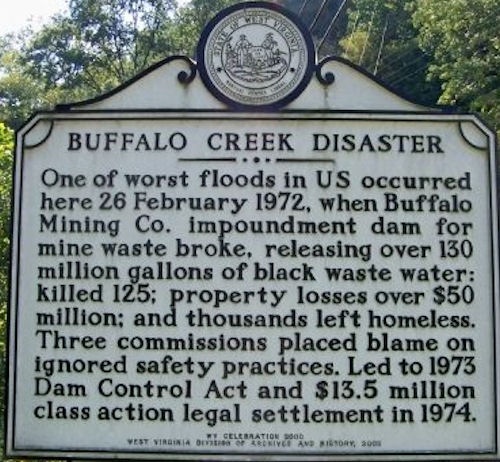 Today, we still have over a hundred active coal sludge dams in West Virginia. Among them are the Shumate’s Branch impoundment just 400 yards upstream from the old Marsh Fork Elementary School and the Brushy Fork impoundment above the communities of Pettus and Whitesville.
Today, we still have over a hundred active coal sludge dams in West Virginia. Among them are the Shumate’s Branch impoundment just 400 yards upstream from the old Marsh Fork Elementary School and the Brushy Fork impoundment above the communities of Pettus and Whitesville.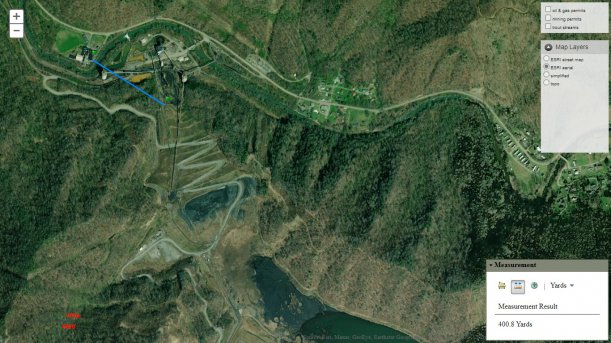 At 2.8 billion gallons, Shumate’s is more than 20 times the volume of the Buffalo Creek disaster. At around 8 billion gallons, Brushy Fork holds more than 60 times the volume. Brushy Fork holds the added distinction of being built over abandoned underground mines, the same way, and by the same company, as the Martin County, KY, sludge dam that broke through in 1994 and again in 2000. Brushy Fork is also adjacent to the Bee Tree mountaintop removal site, which is “inactive” for now but could resume operations, including heavy blasting, whenever the coal company, Alpha Metallurgical Resources, feels like it. But never fear! The coal company’s hired expert has assured them that, even if the underground mines collapsed, everything would be fine. And WV Dept. of Environmental Protection engineer Greg Demyan has stated that blasting next to a dam can be good for it; he googled it.
At 2.8 billion gallons, Shumate’s is more than 20 times the volume of the Buffalo Creek disaster. At around 8 billion gallons, Brushy Fork holds more than 60 times the volume. Brushy Fork holds the added distinction of being built over abandoned underground mines, the same way, and by the same company, as the Martin County, KY, sludge dam that broke through in 1994 and again in 2000. Brushy Fork is also adjacent to the Bee Tree mountaintop removal site, which is “inactive” for now but could resume operations, including heavy blasting, whenever the coal company, Alpha Metallurgical Resources, feels like it. But never fear! The coal company’s hired expert has assured them that, even if the underground mines collapsed, everything would be fine. And WV Dept. of Environmental Protection engineer Greg Demyan has stated that blasting next to a dam can be good for it; he googled it.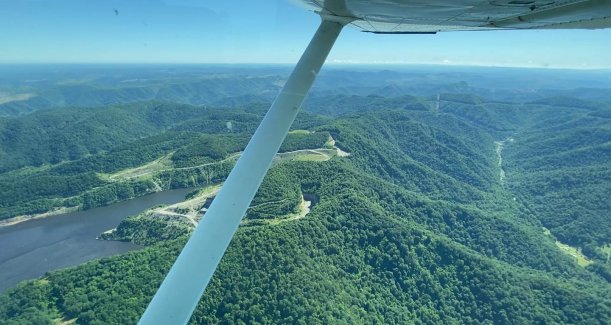 Coal River Mountain Watch outreach coordinator CRMW's Junior Walk, who attended the old Marsh Fork Elementary School and lives downstream of Brushy Fork, had this to say about the 50th anniversary:
Coal River Mountain Watch outreach coordinator CRMW's Junior Walk, who attended the old Marsh Fork Elementary School and lives downstream of Brushy Fork, had this to say about the 50th anniversary:
“It's been fifty years today that the Buffalo Creek coal slurry dam broke open in the head of Buffalo Creek, West Virginia. 125 people lost their lives when that muck flooded out the holler they lived in and destroyed their homes and lives. This day should be marked by mourning here in West Virginia; however, the vast majority of people, even here, have no idea about the true toll that resource extraction has taken on this land and the people who call it home. Today there are more hollers and communities in more danger than in 1972 when the blood of the people of Buffalo Creek was used to grease the wheels of the capitalist system. The largest earthen dam in the western hemisphere sits in the head of a holler above Eunice, Pettus, and Whitesville, West Virginia. It holds back close to 8 billion gallons of the same slurry waste that ripped through Buffalo Creek fifty years ago. It's also taller than Hoover Dam and constructed out of dirt and rock, much like the dam at Buffalo Creek. It is my sincere hope that my family and neighbors don't end up at the bottom of all that slurry, but, much like in 1972, it is still a real everyday possibility.”
The dead and missing are listed here. May they rest in peace. https://archive.wvculture.org/history/buffcreek/mem.html
Coal River Mountain Watch
PO Box 303
Naoma, WV 25140
304-854-2182, coalriver[at]crmw[dot]net






